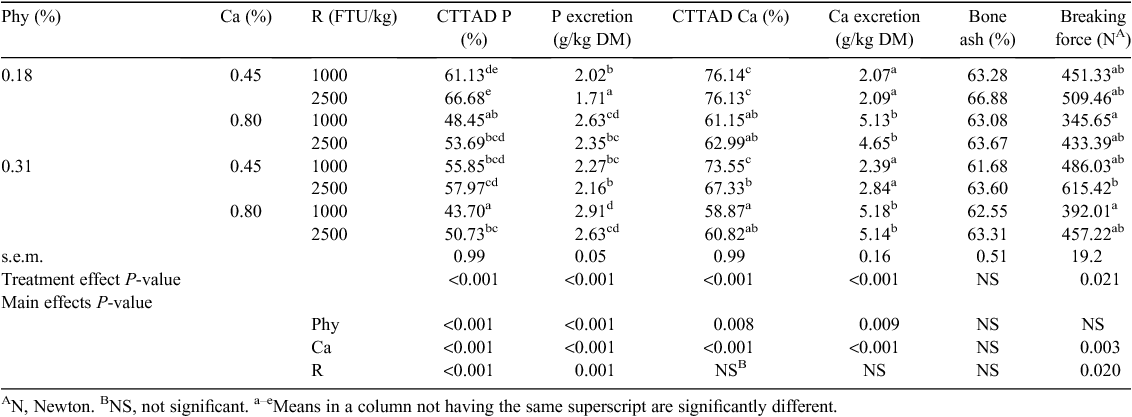Dietary phytate, calcium and phytase levels affect mineral utilisation in weaned pigs
P. Guggenbuhl A B , R. Aureli A and E. Perez Calvo AA DSM Nutritional Products SA, Saint-Louis, France.
B Corresponding author. Email: patrick.guggenbuhl@dsm.com
Animal Production Science 57(12) 2416-2416 https://doi.org/10.1071/ANv57n12Ab091
Published: 20 November 2017
Dietary phytases degrade phytate and so prevent possible phosphorus (P) deficiency, reduce P excretion and maintain animal well-being (Guggenbuhl et al. 2016). The aim of this experiment was to evaluate the effects on P and calcium (Ca) utilisation in weaned pigs fed diets with different levels of phytate (phy), Ca and phytase (R) (Citrobacter braakii; Ronozyme HiPhos, DSM). The hypothesis tested was that R inclusion levels would modulate P and Ca utilisation in the presence of high levels of dietary phy and Ca. The experiment was conducted with 128 28-day-old castrated male weaned pigs (Large-White x Redon) having an initial bodyweight of 7.2 ± 1.2 kg (mean ± s.e.). Pigs were randomly allotted into eight treatment groups of 16 animals each (four pens of four piglets). They were fed ad libitum for 42 days with mash diets based on corn, soybean meal and rapeseed meal. Eight diets were formulated to meet the animal requirements for weaned pigs according to NRC (2012) (crude protein (CP), 198 g/kg; metabolisable energy (ME), 13.0 MJ/kg; total P, 0.47%; total lysine, 1.40%). The experiment was conducted in a 2 × 2 × 2 factorial design with two dietary phy (0.18 and 0.31%), Ca (0.45 and 0.80%) and R (1000 and 2500 FTU/kg) concentrations. The coefficient of total tract apparent digestibility (CTTAD) of P and Ca, excretion of P and Ca, and femoral bone characteristics were evaluated at the end of the experiment. Data were analysed as a 2 × 2 × 2 factorial ANOVA and differences between groups were determined by the Student–Newman–Keuls multiple-range test (significant at P ≤ 0.05) (StatGraphics Centurion XVII, Manugistics, Rockville, MD, USA).
The CTTAD of P was improved (P < 0.05) and P excretion reduced (P < 0.05) with the higher level of R (Table 1). For both P and Ca, the CTTAD was higher (P < 0.05) and the excretion lower (P < 0.05) with low dietary inclusions of phy or Ca. Bone strength was improved (P < 0.05) with increasing amount of R, whereas high dietary Ca reduced (P < 0.05) the bone breaking force. High dietary Ca significantly reduced the overall impact of R on P and Ca digestibility, increased their excretion, and reduced bone strength. High dietary phy induced the same effects except in bones where the breaking force was improved. The high Ca level was in excess and was largely excreted. Ca is an essential nutrient having a high ability to chelate phy and most nutrients released by R (Selle et al. 2009). The binding of Ca to phy reduced the R accessibility to phy, increased the response time and may partially inhibit the R activity.

|
Data from the present study showed that high dietary R could not compensate for the poor P and Ca utilisation observed in pigs fed a diet with high levels of Ca, irrespective of the dietary level of phy.
References
Guggenbuhl P, Perez Calvo E, Fru F (2016) Journal of Animal Science 94, 307–309.| Crossref | GoogleScholarGoogle Scholar |
NRC (2012) ‘Nutrient requirements of swine.’ 12th edn. (National Academy Press: Washington, DC)
Selle PP, Cowieson AJ, Ravindran V (2009) Livestock Science 124, 126–141.
| Crossref | GoogleScholarGoogle Scholar |


